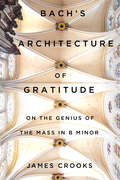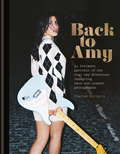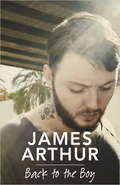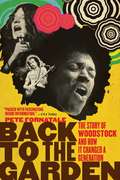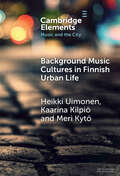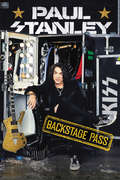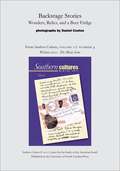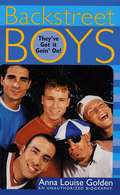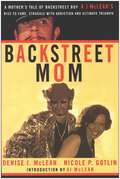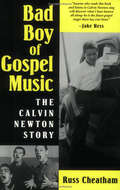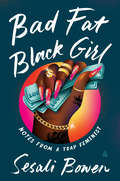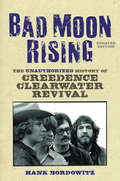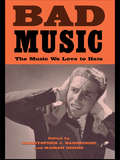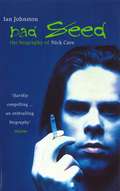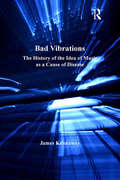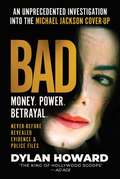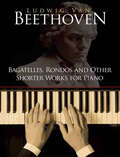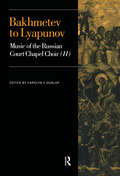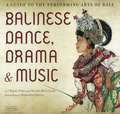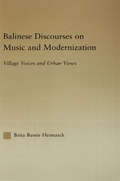- Table View
- List View
Bach’s Architecture of Gratitude: On the Genius of the Mass in B Minor
by James CrooksEvery lover of music finds themselves, at privileged moments, in ecstasy – certain that what they are hearing has captured, somehow, an incontrovertible truth. In Bach’s Architecture of Gratitude James Crooks explores this profound aesthetic experience in a case study of J.S. Bach’s Mass in B Minor – widely considered among the greatest works of the western choral canon.The book begins with an investigation of compositional principles – of what we might call the mass’s musical architecture. Crooks argues that in its cathedral-like structure, Bach gives us a detailed map of the spiritual journey it triggers. This journey culminates in our apprehension of the world as a gift. And that means, in turn, that the mode of knowing appropriate to its musical ecstasy is gratitude. In the gratitude of aesthetic experience, we learn something crucial about the genuine nature of our own identity, our relations with others, and the character of the things around us. Bach’s genius lies in his capacity to frame these lessons in the mass’s choruses, solos, and duets.Spotlighting the wisdom embedded in gratitude, Bach’s Architecture of Gratitude celebrates music as a pathway to understanding our deepest selves and our intimacy with the world.
Back to Amy
by Charles Moriarty'...it's really quite beautiful' Matt Everitt, BBC Radio 6 MusicHappy, beautiful and full of fun - this is an intimate portrait of the real Amy Winehouse.With over 100 photographs - many seen here for the first time - along with personal stories and recollections from Amy's mother, Janis Winehouse, as well as Amy's band members and others close to her, this is a celebration of a young artist on the cusp of fame. Taken by a friend at a relaxed photoshoot just before she released her debut album, these beautiful images give an early glimpse of the girl who would captivate the world.With a foreword by Asif Kapadia, director of Academy Award-winning documentary Amy, and containing fond memories and insights from the people who knew her best, Back to Amy is a tribute to the enduring spirit of a truly special artist.
Back to the Boy
by James Arthur'The thought behind this book is not just me wanting to tell my story in the standard autobiographical fashion but to create a kind of self-help book that includes my story. There are many things people don't know about me and maybe when they read about those things they will have an understanding of the journey I have been on, why I've made the mistakes I have and hopefully help other people overcome their adversities.'Life has presented its fair share of setbacks for James Arthur, from his disrupted childhood - during which he felt like a stray and a misfit, entering the care system in his teens - to a very public fall from favour just at the point when all his dreams should have been coming true. With an extraordinary comeback over the last few months, starting with #1 single Say You Won't Let Go and his Platinum album Back From The Edge, Back To The Boy shows the British singer and songwriter not only reflecting on his past but also his return to the charts, and the phenomenal global success that followed. James shares his struggles with mental health issues which led to drug-abuse, and how he dealt with the feelings of intense pressure and loneliness that accompanied his sudden rise to fame. Back to the Boy gives an insight into the life of one of the most exciting musicians of today, and how his experiences are reflected in the blend of raw emotion and passion in his music. This is a story of hope and self-discovery to inspire those who have ever hit rock-bottom and managed to pick themselves up again.
Back to the Boy
by James Arthur'The thought behind this book is not just me wanting to tell my story in the standard autobiographical fashion but to create a kind of self-help book that includes my story. There are many things people don't know about me and maybe when they read about those things they will have an understanding of the journey I have been on, why I've made the mistakes I have and hopefully help other people overcome their adversities.'Life has presented its fair share of setbacks for James Arthur, from his disrupted childhood - during which he felt like a stray and a misfit, entering the care system in his teens - to a very public fall from favour just at the point when all his dreams should have been coming true. With an extraordinary comeback in 2016, starting with No. 1 single 'Say You Won't Let Go' and his Platinum album Back From The Edge, Back To The Boy shows the British singer and songwriter reflecting not only on his past but also on his return to the charts, and the phenomenal global success that followed. James shares his struggles with mental health issues which led to drug abuse, and how he dealt with the feelings of intense pressure and loneliness that accompanied his sudden rise to fame. Back to the Boy gives an insight into the life of one of the most exciting musicians of today, and how his experiences are reflected in the raw emotion and passion in his music. This is a story of hope and self-discovery to inspire those who have ever hit rock-bottom and managed to pick themselves up again.
Back to the Garden: The Story of Woodstock
by Pete FornataleTHE BIGGEST EVENT IN ROCK 'N' ROLL HISTORY IS BROUGHT VIVIDLY TO LIFE THROUGH ORIGINAL INTERVIEWS WITH ROGER DALTREY, JOAN BAEZ, DAVID CROSBY, RICHIE HAVENS, JOE COCKER, AND DOZENS OF HEADLINERS, ORGANIZERS, AND FANS. For America's counterculture youth in 1969, Woodstock became a symbol of more than just sex, drugs, and rock 'n' roll--it was about peace, love, and a new way of living. It was a seminal event that epitomized the ways that the culture, the country, and the core values of an entire generation were shifting. On one glorious weekend, this generation found its voice through music. Back to the Garden celebrates the spirit of Woodstock in the words of some of the era's biggest musical stars, as well as those who participated in the festival. From Richie Havens's legendary opening act to the Who's violent performance, from the Grateful Dead's jam to Jefferson Airplane's wake-up call, culminating in Jimi Hendrix's career-defining moment, renowned disc jockey Pete Fornatale brings new stories to light and sets the record straight on some common misperceptions. Illustrated with black-and-white photographs, Back to the Garden is the authoritative and highly entertaining history of three days of peace and music
Background Music Cultures in Finnish Urban Life (Elements in Music and the City)
by Heikki Uimonen Kaarina Kilpiö Meri KytöThis Element focuses on how music is experienced, articulated, and reclaimed in urban commercial environments. Special attention is paid to listeners, spaces, and music, co- and re-produced continuously in their triangular relationship affected by social, legal, economic, and technological factors. The study of the historical development of background music industries, construction of contemporary sonic environments, and individual meaning-making is based on extensive data gathered through interviews, surveys, and fieldwork, and supported by archival research. Due to the Finnish context and the ethnomusicological approach, this study is culture-sensitive, providing a fresh 'factory-to-consumer' perspective on a phenomenon generally understood as industry-lead, behavioral, and global. This title is also available as Open Access on Cambridge Core.
Backstage Pass: The Starchild's All-access Guide To The Good Life
by Paul StanleyTheNew York Times bestselling author and KISS rock star grants fans an all-access Backstage Pass to his personal life and rock ‘n’ roll lifestyle.In this follow-up to his popular bestseller Face the Music, Paul Stanley—the Starchild—takes us behind the scenes, revealing what he’s learned from a lifetime as the front man, rhythm guitarist, and driving force of KISS, and how he brings his unique sensibility not only to his music career but to every area of his life—from business to parenting to health and happiness.Backstage Pass takes you beyond the makeup as Paul shares fascinating details about his life—his fitness routine, philosophy, business principles, how he maintains his inspiration, passion, and joy after nearly fifty years of mega success including selling out tours, 100 million albums sold and an art career that has amassed over ten million dollars in sales.Divulging more true stories of the Rock & Roll Hall of Famer’s relationships, hardships, and pivotal moments, it also contains intimate four-color, never-before-seen photos from Paul’s personal collection, and offers surprising lessons on the discipline and hard work that have made him one of the healthiest and most successful rock ‘n’ roll icons in history.This is hard-won advice from a music legend for fans who love living large, but also want to take control and move ahead in everyday life. Paul shows you how you can rock ‘n’ roll all night and party every day—without missing a beat.
Backstage Passes: Life on the Wild Side with David Bowie
by Angela Bowie Patrick CarrThere are countless books about the great rock/pop icon of the twentieth century, David Bowie. But only one written by the woman who met him aged just nineteen, married him, had a child with him and helped shape his image and the early stages of his career. In one of the great rock'n'roll exposés, Angela Mary Hartnett Bowie gives a riveting account of her years with Bowie and his progress from aspiring young singer to international rock stardom. She emerges as a witty, powerful personality in her own right, and as his partner of ten years has insights into his background and personality that are exclusively hers. American, educated in Cyprus, Switzerland, the US and then London, Angie brought her confidence and sophistication to the young David’s life and is credited with conceptualizing the costumes for the Ziggy Stardust stage show, which was his breakthrough to success. This is a fascinating glimpse into the music and club scene of early seventies London, and later the rock lifestyle in New York and Los Angeles. Angie knew everyone and gives a colorful, wry account of the ambience, and her brushes with other giants of the decade - Jagger, Elton John, Lou Reed, the Jacksons and members of Led Zeppelin, to name just a few. Her story gives a unique take on life with the inscrutable Bowie and she recounts the dissolution of their marriage, and his descent into cocaine addiction, with courage and charm.
Backstage Stories: Wonders, Relics, and a Beer Fridge (Southern Cultures #17:4)
by Daniel CostonThe headlining band were nasty rogues, hitting on freakishly skinny underage chicks while I heard it all half asleep."Captured on film: Johnny Cash, Tift Merrit, the Avett Brothers, and many other artists. And some of them reveal their tales about the most celebrated and notorious space on any tour (aside from the stage itself).<br>This article appears in the 2011 Music issue of Southern Cultures.Southern Cultures is published quarterly (spring, summer, fall, winter) by the University of North Carolina Press. The journal is sponsored by the University of North Carolina at Chapel Hill's Center for the Study of the American South.
Backstreet Boys
by Anna Louise GoldenWhen they say Quit Playing Games With My Heart, you better listen-- 'cause they're the Backstreet Boys, one of the hottest boy-bands ever to take the stage. These five ultra-fine guys have won the hearts of millions. So step back into their awesome world and see what made them tick at this exciting, early stage of their careers. An insider's look back at the band: Howie Dorough was the peacemaker of the group. But watch out-this flirtatious hunk was also known as the "Latin lover." Kevin Richardson, as the group's gorgeous oldest member, sometimes had to be the responsible one. Nick Carter, the band's youngest member, wasn't called "Chaos" for nothing-- this blond-haired, blue-eyed cutie was a major prankster! Brian Littrell, a big-time hottie, was the comedian of the bunch-- Jim Carrey was his idol, and he loved to play practical jokes. AJ McLean, deeply romantic-- he wrote the band's love ballads, and this sexy songster was rarely seen without his trademark sunglasses.Fall in love all over again with the Backstreet Boys as they celebrate more than twenty years of top-charting success.
Backstreet Mom: A Mother's Tale of Backstreet Boy AJ McLean's Rise to Fame, Struggle with Addiction, and Ultimate Triumph
by Denise I. McLean Nicole P. GotlinFeatured on "Oprah" and "Good Morning America. Backstreet Mom is the story of one single mother's courageous battle to save her son could be the story of any woman with a child in trouble. There's more money at stake, more public attention and a larger than life career in the balance. An integral part of the Backstreet Boys from the very beginning, AJ McClean's mother, Denise, traveled with the group and served as their publicist and fan club coordinator. In close proximity to the successes and heartbreaks of her son's career, Denise watched her son's painful descent into alcoholism and depression. This revealing account tells the tale of AJ's rise to superstardom, his decline into addiction, and his struggles through rehab, and offers a look at the harsh world of the music industry. Any mother who's ever faced the pain of a child unraveling will find herself in the pages of this honest and inspiring memoir.
Bad Boy of Gospel Music: The Calvin Newton Story (American Made Music Series)
by Russ Cheatham“I messed up,” Calvin Newton lamented, after wasting thirty years and doing time in both state and federal prisons for theft, counterfeiting, and drug violations. “These were years of my life that I could have been singing gospel music.” During his prime, he was super-handsome, athletic, and charged with sexual charisma that attracted women to him like flies to honey. Atop this abundance was his astounding voice, “the voice of an angel.” This book is his prodigal-son story. Audacious, Newton never turned down a dare, even if it meant climbing on the roof of a speeding car or wading into a freezing ocean. As a boy boxer, he was a Kentucky Golden Gloves champ who k.o.’ed his opponent in twenty-three seconds. By his late teens he had been recruited by the Blackwood Brothers, the number-one gospel quartet in the world. In his mid-twenties while he was singing Christian songs with the Oak Ridge Quartet, Newton’s mighty talent and movie-star looks took him deep into hedonism--reckless driving, heavy romancing, and addictive pill popping. As 1950s rock ‘n’ roll began its invasion of gospel, he and two partners formed the Sons of Song, the first all-male gospel trio. Long before the pop sound claimed contemporary Christian music, the Sons of Song turned gospel upside down with histrionic harmony, high-styled tuxedos, and Hollywood verve. Their signature song, “Wasted Years,” foreshadowed Newton’s punishing fall. This biography looks back at the destructive lifestyle that wrecked a sparkling career. When well into his sixties, Newton turned his life around and was able to confront his demons and discuss his prodigal days. He talked extensively with Russ Cheatham about his self- destruction and the great personal expense of his own bad-boy choices and late redemption. In this candid biography, one of gospel’s all-stars discloses a messed-up life that vacillated between achievement and failure, fame and infamy, happiness and grief.
Bad Boy of Music
by George AntheilThe memoirs of George Antheil, 1900-1959. No musician has ever written memoirs such as these, until the much later work of Ned Rorem, perhaps partly because few musicians can write, and chiefly because no musician, not even the most wild-haired, has had a life like the one George Antheil is currently enjoying. Witty, glittering, packed full of the bizarre, these pages record the fabulous career of an extraordinary pianist, composer, and writer who got his introduction to music in plebeian Trenton when two innocent-looking old ladies covered up a jailbreak by thundering on the piano. After Trenton, nothing about George Antheil's life has been plebeian. Practicing the piano sixteen hours a day, he toured Europe, played French compositions in Germany, married a Hungarian in Paris, and there became a leader of Left Bank iconoclasts. In 1929 he returned to America for the performance of his "Ballet Mécanique" (scored for machines and airplane propeller), which caused a sensation among critics and sent him penniless back to Europe. In 1933 he returned again to America, where he led an even more checkered career, writing several books, magazine articles which have since become famous, and indulging his favorite hobby of, obviously, glandular criminology. Then he went to Hollywood, did the score for The Scoundrel, ran an advice-to-the-lovelorn column called "Boy Advises Girl," and composed a highly successful Fourth Symphony. If the mere framework of his life is colorful, the details are even more so. Like those of Oscar Levant's A Smattering of Ignorance, his pages are alive with famous personalities: the eccentric Stravinsky, James Joyce, Gertrude Stein, Stokowski, Dalí, Hedy Lamarr, to mention a few. But Bad Boy of Music is also a serious yet never obscure inside story of how it feels and what it takes to be a concert artist--a sober story abundant in illuminating and profound thoughts upon music and art in general.
Bad Fat Black Girl: Notes from a Trap Feminist
by Sesali BowenFrom funny and fearless entertainment journalist Sesali Bowen, Bad Fat Black Girl combines rule-breaking feminist theory, witty and insightful personal memoir, and cutting cultural analysis for an unforgettable, genre-defining debut. <p><p> Growing up on the south side of Chicago, Sesali Bowen learned early on how to hustle, stay on her toes, and champion other Black women and femmes as she navigated Blackness, queerness, fatness, friendship, poverty, sex work, and self-love. Her love of trap music led her to the top of hip-hop journalism, profiling game-changing artists like Megan Thee Stallion, Lizzo, and Janelle Monae. But despite all the beauty, complexity, and general badassery she saw, Bowen found none of that nuance represented in mainstream feminism. Thus, she coined Trap Feminism, a contemporary framework that interrogates where feminism meets today's hip-hop. <p><p> Bad Fat Black Girl offers a new, inclusive feminism for the modern world. Weaving together searing personal essay and cultural commentary, Bowen interrogates sexism, fatphobia, and capitalism all within the context of race and hip-hop. In the process, she continues a Black feminist legacy of unmatched sheer determination and creative resilience. <p><p> Bad bitches: this one’s for you.
Bad Moon Rising: The Unauthorized History of Creedence Clearwater Revival
by Hank BordowitzRightly called the saddest story in rock 'n' roll history, this Creedence biography--newly updated with stories from band members, producers, business associates, close friends, and families--recounts the tragic and triumphant tale of one of America's most beloved bands. Hailed as the great American rock band from 1968 to 1971, Creedence Clearwater Revival captured the imaginations of a generation with classic hits like "Proud Mary," "Down on the Corner," "Green River," "Born on the Bayou," and "Who'll Stop the Rain." Mounting tensions among bandmates over vibrant guitarist and lead vocalist John Fogerty's creative control led to the band's demise. Tracing the lives of four musicians who redefined an American roots-rock sound with unequaled passion and power, this music biography exposes the bitter end and abandoned talent of a band left crippled by debt and dissension.
Bad Music: The Music We Love to Hate
by Christopher Washburne Maiken DernoWhy are some popular musical forms and performers universally reviled by critics and ignored by scholars-despite enjoying large-scale popularity? How has the notion of what makes "good" or "bad" music changed over the years-and what does this tell us about the writers who have assigned these tags to different musical genres? Many composers that are today part of the classical "canon" were greeted initially by bad reviews. Similarly, jazz, country, and pop musics were all once rejected as "bad" by the academy that now has courses on these and many other types of music. This book addresses why this is so through a series of essays on different musical forms and performers. It looks at alternate ways of judging musical performance beyond the critical/academic nexus, and suggests new paths to follow in understanding what makes some music "popular" even if it is judged to be "bad." For anyone who has ever secretly enjoyed ABBA, Kenny G, or disco, Bad Music will be a guilty pleasure!
Bad Seed: The Biography of Nick Cave
by Ian JohnstonA widely acclaimed biography of one of rock's most compelling, uncompromising and influential singer-songwriters, Ian Johnston's BAD SEED offers a superb overview of Nick Cave's career to date. Through Cave's fronting of the incendiary bands The Birthday Party and The Bad Seeds, producing music of unfettered expression and explosive intensity, to his creative collaborations outside of the rock industry in film and literature, BAD SEED illustrates a life lived in barely controlled chaos: and unravels the motivation and unique appeal of a reluctant icon whose songs, according to the Rolling Stones, possess "the authority of the most primal kind of myth."
Bad Seed: The Biography of Nick Cave
by Ian JohnstonA widely acclaimed biography of one of rock's most compelling, uncompromising and influential singer-songwriters, Ian Johnston's BAD SEED offers a superb overview of Nick Cave's career to date. Through Cave's fronting of the incendiary bands The Birthday Party and The Bad Seeds, producing music of unfettered expression and explosive intensity, to his creative collaborations outside of the rock industry in film and literature, BAD SEED illustrates a life lived in barely controlled chaos: and unravels the motivation and unique appeal of a reluctant icon whose songs, according to the Rolling Stones, possess "the authority of the most primal kind of myth."
Bad Vibrations: The History of the Idea of Music as a Cause of Disease (The History of Medicine in Context)
by James KennawayMusic has been used as a cure for disease since as far back as King David's lyre, but the notion that it might be a serious cause of mental and physical illness was rare until the late eighteenth century. At that time, physicians started to argue that excessive music, or the wrong kind of music, could over-stimulate a vulnerable nervous system, leading to illness, immorality and even death. Since then there have been successive waves of moral panics about supposed epidemics of musical nervousness, caused by everything from Wagner to jazz and rock 'n' roll. It was this medical and critical debate that provided the psychiatric rhetoric of "degenerate music" that was the rationale for the persecution of musicians in Nazi Germany and the Soviet Union. By the 1950s, the focus of medical anxiety about music shifted to the idea that "musical brainwashing" and "subliminal messages" could strain the nerves and lead to mind control, mental illness and suicide. More recently, the prevalence of sonic weapons and the use of music in torture in the so-called War on Terror have both made the subject of music that is bad for the health worryingly topical. This book outlines and explains the development of this idea of pathological music from the Enlightenment until the present day, providing an original contribution to the history of medicine, music and the body.
Bad: An Unprecedented Investigation into the Michael Jackson Cover-Up (Front Page Detectives)
by Dylan HowardAn Inside View into the Dark Side of a Music Icon He was the King of Pop, a superstar without equal, the idol of millions of young people around the world. But was Michael Jackson also a sexual predator without equal, someone who preyed on the very fans who adored him? Bad is the revelatory untold true story of the strange and larger-than-life career of Michael Jackson, the King of Pop. In the wake of the controversial two-part documentary Leaving Neverland, which told the stories of two young boys who were befriended by the singer and have claimed they suffered years of agonizing abuse, Dylan Howard set out to investigate Jackson&’s life and death in unprecedented depth, to determine—as one lawyer suggested—that the pop star ran &“the most sophisticated child sexual abuse procurement and facilitation operation the world has known.&” After all the highly publicized trials and unfounded accusations, stunning new information has finally come to light: irrefutable evidence that one of the best-known, best-loved figures in the world was a monster behind closed doors—a foul-mouthed, abusive, drug-sodden freak whose deeds and the reasons for those deeds are revealed now for the first time. A dramatic narrative account based on dozens of interviews, Howard shares Jackson&’s own riveting personal journal—obtained exclusively for this book—interviews with family members, multiple first-person sources—some of whom have asked to remain anonymous—as well as thousands of pages of court documents. What he uncovers is a man who was both naive and Machiavellian, unorthodox, a devoted father, shrewd businessman, and drug addict whose life was cut short but whose sound and style have influenced artists of various genres and generations. Remarkably though, in death, there remains two portraits of Michael Jackson: the reigning King of Pop, and a pedophile whose pattern of abuse ruined his reputation. Fans and individuals alike will forever be asking if the insidious claims being made about MJ are true. This is the new narrative and the sad legacy of one of the best-selling music artists of all time. Here is his life story, told for the first time with stories and testimony that will leave you shaken.
Bagatelles, Rondos and Other Shorter Works for Piano
by Ludwig Van BeethovenUniversally recognized for his critically important role in raising instrumental music to its highest plane, Beethoven is also highly regarded for his leadership in developing and extending the piano repertoire. His bagatelles, once described by the composer himself as "Kleinigkeiten" -- or "trifles" -- are short, masterful works that have proved tremendously popular not only for their pleasing sounds but also for the technical challenges they offer intermediate as well as advanced piano students.This superb, high-quality collection, reproduced from the authoritative Breitkopf & Härtel edition, contains the composer's most popular and most performed bagatelles, rondos, and shorter compositions, including: Six Minuets (c. 1795); the Polonaise in C, Op. 89 (1814); Six Bagatelles, Op. 126 (1823-24); the famed Rondo a capriccio in G (Rage Over a Lost Penny, 1795); the Andante in F (Andante favori, 1803), and a generous selection of other short works. An easily affordable volume, the present edition provides Beethoven devotees, students, teachers, and music lovers with a delightful sampling of a number of spirited works by one of the music world's supreme masters.
Bakhmetev to Lyapunov: Music of the Russian Court Chapel Choir II (Music Archive Publications #8)
by Carolyn C. DunlopFirst Published in 2000. Routledge is an imprint of Taylor & Francis, an informa company.
Balinese Dance, Drama & Music
by Rucina Ballinger I Wayan Dibia Barbara AnelloThis book is a lavishly illustrated introduction to the most commonly seen forms of traditional performing arts in Bali; gamelan music, dance, drama and puppetry. Ideal reading for visitors to the island as well as for anyone interested in Balinese culture. The book presents the history and function of each type of performance with illustrations and photographs to aid in identification. Introductory sections discuss the way performing arts are learned in Bali and the principal Balinese values that are passed on in these forms, as well as some of the basic religious and cultural tenets that are expressed in the arts and the functions of the forms themselves.This book is enhanced with a bibliography and discography and over 200 photographs and specially prepared watercolors of Balinese performances.
Balinese Dance, Drama & Music
by Rucina Ballinger I Wayan Dibia Barbara AnelloThis book is a lavishly illustrated introduction to the most commonly seen forms of traditional performing arts in Bali; gamelan music, dance, drama and puppetry. Ideal reading for visitors to the island as well as for anyone interested in Balinese culture. The book presents the history and function of each type of performance with illustrations and photographs to aid in identification. Introductory sections discuss the way performing arts are learned in Bali and the principal Balinese values that are passed on in these forms, as well as some of the basic religious and cultural tenets that are expressed in the arts and the functions of the forms themselves.This book is enhanced with a bibliography and discography and over 200 photographs and specially prepared watercolors of Balinese performances.
Balinese Discourses on Music and Modernization: Village Voices and Urban Views (Current Research In Ethnomusicology: Outstanding Dissertations Ser. #Vol. 5)
by Brita Heimarck ReneeWhile many Western scholars have discussed the technical aspects of Balinese music or the traditional contexts for performance, little has been written in Western languages about Balinese discourses on their music. This dissertation seeks to understand the experience of music in Bali according to Balinese voices through an analysis of oral and written dialogues on music, mainly by musicians and dalangs (shadow play puppeteers) from the village of Sukawati, scholars, teachers, administrators and students from the Indonesian College of the Arts (STSI) in the City of Denpasar. The study examines the influence of modernization on the traditional arts and their role in society. A concentration on Balinese discourses enables individual performers and scholars to represent themselves to a greater extent than previously seen in ethnomusicological scholarship, making this study more of a critical discussion among equals than a Western interpretation of 'others'. This approach permits a rare view into contemporary Balinese conceptions and practices of music.
